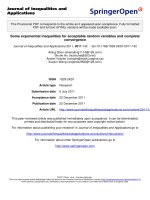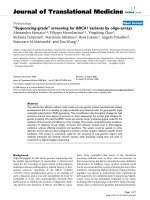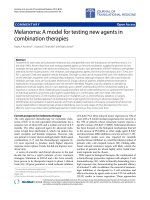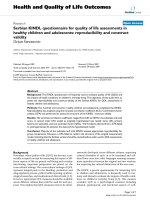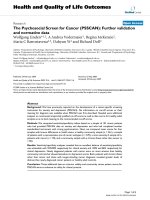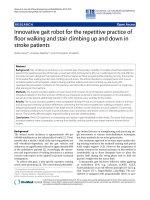báo cáo hóa học: " Socially assistive robotics for post-stroke rehabilitation" potx
Bạn đang xem bản rút gọn của tài liệu. Xem và tải ngay bản đầy đủ của tài liệu tại đây (730.43 KB, 9 trang )
BioMed Central
Page 1 of 9
(page number not for citation purposes)
Journal of NeuroEngineering and
Rehabilitation
Open Access
Research
Socially assistive robotics for post-stroke rehabilitation
Maja J Matarić*
1
, Jon Eriksson, David J Feil-Seifer*
1
and Carolee J Winstein
2
Address:
1
Computer Science Department, University of Southern California, Los Angeles, CA, USA and
2
Department of Neurology, University of
Southern California, Los Angeles, CA, USA
Email: Maja J Matarić* - ; Jon Eriksson - ; David J Feil-Seifer* - ;
Carolee J Winstein -
* Corresponding authors
Abstract
Background: Although there is a great deal of success in rehabilitative robotics applied to patient
recovery post stroke, most of the research to date has dealt with providing physical assistance.
However, new rehabilitation studies support the theory that not all therapy need be hands-on. We
describe a new area, called socially assistive robotics, that focuses on non-contact patient/user
assistance. We demonstrate the approach with an implemented and tested post-stroke recovery
robot and discuss its potential for effectiveness.
Results: We describe a pilot study involving an autonomous assistive mobile robot that aids stroke
patient rehabilitation by providing monitoring, encouragement, and reminders. The robot navigates
autonomously, monitors the patient's arm activity, and helps the patient remember to follow a
rehabilitation program. We also show preliminary results from a follow-up study that focused on
the role of robot physical embodiment in a rehabilitation context.
Conclusion: We outline and discuss future experimental designs and factors toward the
development of effective socially assistive post-stroke rehabilitation robots.
Background
Stroke is a major cause of neurological disability. Most of
those affected are left with some loss of movement.
Through concerted use and training of the affected limb
during the critical post-stroke period, such disability can
be significantly reduced [1]. The rate and amount of
recovery greatly depends on the amount of focused train-
ing, along with stroke severity and cognitive availability.
Evidence shows that the intensity and frequency of
focused therapy can improve functional outcomes [2].
However, since such rehabilitation normally requires
supervision of trained professionals, lack of resources lim-
its the amount of time available for supervised rehabilita-
tion. As a result, the quality of life of patients post stroke
is dramatically reduced, and medical costs and lost pro-
ductivity continue to be incurred.
Due to the high instance of stroke today, and its increasing
rate in the growing elderly population, post-stroke robot-
assisted therapy is an area of active research. A number of
effective systems have been developed, using physical
assistance in order to achieve rehabilitative goals. How-
ever, not all effective rehabilitation therapy requires the
use physical contact between the therapist and the patient.
Non-contact therapy constitutes the motivation for our
work on robotic social interaction as a tool for post-stroke
rehabilitation. In this paper, we describe a contact-free
socially-assistive post-stroke therapeutic robot system. We
Published: 19 February 2007
Journal of NeuroEngineering and Rehabilitation 2007, 4:5 doi:10.1186/1743-0003-4-5
Received: 24 April 2006
Accepted: 19 February 2007
This article is available from: />© 2007 Matarić et al; licensee BioMed Central Ltd.
This is an Open Access article distributed under the terms of the Creative Commons Attribution License ( />),
which permits unrestricted use, distribution, and reproduction in any medium, provided the original work is properly cited.
Journal of NeuroEngineering and Rehabilitation 2007, 4:5 />Page 2 of 9
(page number not for citation purposes)
also show how such therapy methodology fits into cur-
rently used post stroke therapies, since the goal of socially
assistive robots is not to replace existing therapies and
therapists but to augment current options and allow for
greater flexibility for both patients and therapists.
Post-Stroke Assistive Robotics
Robotics used for post-stroke rehabilitation falls under
the broad field of Assistive Robotics (AR). This research
area includes rehabilitative robotics, wheelchair robots
and other mobility aids, companion robots, manipulator
arms for the physically disabled, and educational robots.
Assistive robots are intended for use in a range of environ-
ments, including hospitals, physical therapy centers,
schools and eventually homes. As noted earlier, the vast
majority of post-stroke rehabilitative robots rely on phys-
ical interaction to achieve their therapeutic goals [3-6].
However, physical contact between a robot and a patient
and, in some cases, the powered movement of a patient's
arm by a robot, creates legitimate safety concerns. Such
concerns can be prohibitive in introducing a novel ther-
apy.
Constraint-Induced Therapy
In addition to safety issues involved in hands-on machine
assisted rehabilitation, other reasons exist for considering
hands-off non-contact rehabilitation as a complement,
not a replacement, for hands-on therapy. Specifically,
effective therapeutic regimens involving no physical con-
tact between the therapist and patient have been demon-
strated. As a prominent example, Constraint-Induced (CI)
therapy is a method currently undergoing Phase III evalu-
ation [7] that has promise (results under review) to
increase upper-limb functionality [8] when performed
during the initial plasticity period following a stroke and
up to a year after [9].
The therapy requires the patient to wear a constraining
mitt over the arm unaffected by stroke for the fourteen
waking hours of the day. During this period, the patient is
asked to do as much as physically possible with the stroke-
affected arm in order to promote recovery and re-learning.
For up to six hours per day, the patient undergoes physical
therapy of a functional nature. During this time, the
patient is asked to perform several daily tasks, such as
moving pencils from one bin to another, turning pages in
a newspaper, and putting magazines on a shelf. The
patient is monitored by a physical therapist and given
encouragement and verbal suggestions as to the proper
muscle movements; however, no physical assistance is
given.
CI therapy has been shown to be effective, but it requires
many hours of dedicated one-on-one care between the
patient and the physical therapist. Given the vast and
growing post-stroke population, the availability of an
individual therapist for up to six hours per day is not prac-
tical. The resulting need creates a niche for socially assistive
robotics technology capable of filling the gap created by the
lack of availability of human care.
Furthermore, studies have shown that the major cause of
poor adherence to and lack of compliance with rehabilita-
tion exercises is due to a lack of motivation [10]. A person-
alized robot can monitor progress during the physical
therapy and daily life, and provide tireless motivation,
encouragement, and guidance to the patient, without
involving any physical contact. Such socially assistive
technology is the focus of our work described in this
paper.
Socially Assistive Robotics
Fong et al. [11] described a taxonomy for Socially Interac-
tive Robots (SIR), machines that interact primarily
through social interaction. The term was coined in order
to distinguish tele-operation (i.e., remote control) from
social interaction in Human-Robot Interaction (HRI). We
define Socially Assistive Robotics (SAR) as the intersection of
Assistive Robotics (AR) and SIR [12]. SAR shares with AR
the goal of providing assistance to human users, but SAR
constrains that assistance to be through non-physical
social interaction. Rather than focus on the interaction
itself, as is done in SIR, SAR focuses on achieving specific
convalescence, rehabilitation, training, or education
goals. By addressing social rather than physical interac-
tion, the majority of the safety concern is alleviated. The
motivation for defining this new and growing research
area comes in response to a new niche in rehabilitation,
which can bring together researchers from multiple disci-
plines around a promising new area of research.
Taxonomic Description
In Fong et al. [11], several relevant concerns and methods
of classifications were collected into the following taxon-
omy (see Table 1) for classifying socially interactive robot-
ics (SIR).
To create a taxonomy of SAR, we include all of the ele-
ments from the above SIR taxonomy, and also add the fol-
lowing new components (see Table 2) specific to SAR
[12].
In the research presented in this paper, we focus on the
above components of the taxonomy: embodiment, per-
sonality, user modeling, the task description, and the role
of the robot in the rehabilitation process.
Each is briefly discussed next.
Journal of NeuroEngineering and Rehabilitation 2007, 4:5 />Page 3 of 9
(page number not for citation purposes)
Embodiment
The role of the physically embodied robot in a socially-
assistive context is of key importance, yet may be seen as
counter-intuitive. It may not be obvious why a robot is
needed at all, when instead a personal digital assistant
(PDA) or ubiquitous home computer system might be
used. While there is ample anecdotal evidence to support
the importance of the physical robot sharing the context
of the user and its positive impact on user engagement
and motivation, there are currently few concrete results
that compare robots to computers and other assistive
technologies. This is therefore one of the foci of our
research.
Personality
The personality of a robot could have great effect on the
patient's compliance with and enjoyment of that robot.
One study has addressed the effects of personality on a
user's performance during a task [13], however there has
so far been no work on the long-term effects of the robot's
personality on the effectiveness in a rehabilitation task.
Since it has been shown that pre-stroke personality has an
impact on the rate of post-stroke recovery [14], it is impor-
tant to explore how user personality relates to robot per-
sonality in rehabilitative settings. We have so far
performed two studies focused on user personality, the
use of personal space, and user-robot personality match-
ing [15,16]. Many challenging research issues remain to
be addressed in order to gain insight into time-extended
personalized socially assistive human-robot interaction.
User Modeling
Another area of relevant research is how to effectively
observe and model the patient in a therapeutic setting. In
addition to monitoring task performance, it is also impor-
tant for the robot to observe the patient's social affect indi-
cated by facial expressions, gestures, tone of voice, and
body language. Our work is also beginning to measure
therapy-relevant signals such as interest and frustration
levels. These factors would directly inform the system of
the condition of the patient and allow the robot to mod-
ulate its interaction in order to maximize its effectiveness.
The use of such physiological signals as input for robot-
assisted post-stroke therapy is a new and promising direc-
tion of assistive robotics.
Task Description and Role of the Robot
The description of the task and the role of the robot have
great influence on each other and the process of robot-
assisted therapy. Since we intend to insert a robot aide
Table 2
User Populations The populations that the robot is meant to interact with. Examples include the elderly, individuals with physical
impairments, individuals in convalescent care, individuals with cognitive disorders, and students.
Task Description The task that the robot is meant to achieve. Examples include tutoring, physical therapy, and daily life assistance.
Sophistication of Interaction How the robot interacts with a user, and how the user in turn reacts to the robot.
Role of Robot Is the robot a physical therapist, a nurse's assistant, a tutor, etc.?
Table 1
Embodiment Representing an abstraction as a physical entity.
Emotion Impulse that moves an organism to action.
Dialog Joint process of communication.
Personality The set of distinctive qualities that distinguish individuals.
Human-Oriented Perception The ability to perceive the world as humans do. Relating those perceptions in human-understandable terms.
User Modeling The ability to measure human social behavior. The interpretation of human behavior.
Socially Situated Learning An individual acting with its social environment to acquire new competencies.
Intentionality Individual's actions are a result of intended behaviors by the individual.
Journal of NeuroEngineering and Rehabilitation 2007, 4:5 />Page 4 of 9
(page number not for citation purposes)
into an existing therapy regimen, the robot's goals must
not interfere with or needlessly duplicate existing efforts
made during therapy. Instead, robot-assisted therapy
must complement existing care to enhance the experience
for the patient. Because time-extended interactions with
the patient, involving many hours per day and for several
months, issues of robot personality, authority, and attach-
ment must also be considered.
This paper outlines our pilot work addressing the key
issues above, and describes ongoing follow-up work that
continues to expand on those results toward increased
effectiveness of socially assistive robotics for recovery
post-stroke.
Methods and Results
A key goal of our research is to gain insight into assistive
human-robot interaction (HRI). Toward that end, we
have performed pilot studies examining the effects of HRI
modalities on post-stroke therapy performance, and
methods for user modeling involving motion capture.
This section describes those studies. We performed a pilot
study with a socially assistive mobile robot. This robot
participated in simple therapeutic interactions with
patients post-stroke in the process of performing rehabili-
tation exercises such as arm movements and shelving
magazines [17]. The approach involved the development
of a safe, user-friendly, and affordable mobile robot, capa-
ble of following the patient in an indoor environment.
The robot monitored the patient's use of the stroke-
affected limb, and provided encouragement, guidance,
and reminders. It also logged the patient's movement of
the affected limb and kept track of rehabilitation progress
for reporting to the physical therapist.
The robot behaved in response to the sensed movements
of the monitored stroke-affected limb. It provided gentle
reminders and prompting to the participant if the affected
arm had not been active for some period, and praise and
encouragement if it had. The robot was also able to report
performance data in analytical form to the rehabilitation
staff, for use in fine-tuning the robot-assisted therapy.
Motion Capture
Monitoring a patient's progress during a task is of para-
mount importance to effective therapy. Jovanov et al. [18]
have shown that computer monitoring of a patient's
progress in a walking task can be effectively employed for
computer-assisted therapy. We developed a portable
motion capture system (see Figure 1) which registers the
patient's movement with light-weight inertial measure-
ment units (IMU) worn on the monitored limb, much
like a wristwatch on a Velcro strap [19]. Data from the
motion capture units (see Figure 2) are sent wirelessly to
a receiver on the robot for analysis, thus providing the
robot with real-time and accurate patient movement
monitoring capability. Importantly, this mechanism does
not require the patient to sit or stand in a particular area;
the patient can move freely both indoors and outdoors,
thereby providing feedback about natural functional
movements as well as specific rehabilitation exercises.
We conducted a pilot study on the effectiveness of using
motion capture and non-contact reinforcement with 6
subjects that are part of a larger IRB-approved stroke reha-
bilitation study. Each participant was monitored using the
above-described motion capture system. Only a single
capture unit was used on the affected limb, as only up-
down movement was used in this study; the use of multi-
ple units would provide more detailed information about
limb use.
Design
The robot (see Figure 3) used a standard Pioneer2 DX
mobile robot base. A SICK LMS200 scanning laser range-
finder enabled it to find and track the participant's legs.
For obstacle avoidance, the laser is used together with the
on-board sonar array. A Sony pan-tilt-zoom (PTZ) camera
allows the robot to "look" at and away from the partici-
pant, shake its "head" (camera), and make other commu-
nicative actions. The camera can also be used to find and
track a participant wearing colored markers (as was done
in an earlier set of experiments we performed). A speaker
produces pre-recorded or synthesized speech and sound
effects. The motion capture unit provides movement data
Motion capture mechanismFigure 1
Motion capture mechanism. Components of the motion
capture mechanism used in monitoring limb movement.
Shown are the transmitter and receiving units (top left and
right) and two of the sensor arm-bands (bottom and middle).
For scale, sensor box (white) on the arm-band is 5.5 cm on
the side.
Journal of NeuroEngineering and Rehabilitation 2007, 4:5 />Page 5 of 9
(page number not for citation purposes)
to the robot wirelessly in real time. The robot control soft-
ware was implemented using the Player robot control sys-
tem [20].
We focused on studying how different robot behaviors
may affect the patient's willingness to comply with the
rehabilitation program. Specifically, we tested different
voices, movements, and levels of patience on the part of
the robot, and correlated those with participant compli-
ance, i.e., adherence to the exercises. In addition to col-
lecting data about the participant's movement, the
human-robot interaction, and task compliance, we also
conducted exit interviews and had all participants fill out
questionnaires about their impressions of the robot.
Finally, all experiments were video-recorded for subse-
quent analysis.
Experiment
The robot system was evaluated in three sessions, each of
which featured two subjects. The first session was per-
formed with a non-patient user, while the other two ses-
sions were conducted with stroke survivors. All sessions
took place in rehabilitation research labs at the University
of Southern California Health Sciences campus. Of the six
stroke patients, two were women; all were middle-aged.
The stroke impairment occurred on different limbs
among the patients but all were sufficiently mobile to per-
form the activities in the experiments.
The experiments lasted about one hour per person. Every
evaluation session comprised six experimental runs. Thus,
a total of 36 experiments were performed. In all experi-
ments, the robot asked the participant to perform one of
two activities. The first activity was to shelve magazines; its
difficulty could be adjusted by using magazines with dif-
ferent weights and varying the height of the bookshelf
(Figure 4, left). The robot used the arm motion capture
data to determine whether the activity was being per-
formed. Since the robot only received data about the
movement of the arm, and not the load on the arm, it was
possible to fool the robot by raising the arm without hold-
ing a magazine; one patient so fooled the robot (and
enjoyed this as an entertaining game). To get around this,
the number of magazines shelved was used as the final
validation. The second activity consisted of any voluntary
activity that involved the movement of the affected arm
(Figure 4, right). Here, the robot measured arm move-
ment as an averaged derivative of the arm angle. The com-
pliance measure used in this condition was the total time
during which the participant performed the activity.
The robot recognized participant arm movements using
the motion capture mechanism described above (see Fig-
ure 2), and employed a simple model based on the angle
between the arm and the normal to the floor as an indica-
tor of reaching. Figure 2 shows when reaching was
detected and when prompting and encouragement were
triggered in its absence.
Pioneer mobile robotFigure 3
Pioneer mobile robot. The mobile robot base used in the
experiments. Shown is the laser (box at bottom with USC
sticker), camera (mounted on top of the laser), and micro-
phone (mounted on top of the camera).
Motion capture outputFigure 2
Motion capture output. A patient's arm activity during an
experiment. The thin arrows show when a reaching motion
is detected. The thick arrows show when arm inactivity trig-
gers the robot to encourage the patient.
Journal of NeuroEngineering and Rehabilitation 2007, 4:5 />Page 6 of 9
(page number not for citation purposes)
As noted above, three experiments were performed by
each participant and for each activity. In each experiment,
a different human-robot interaction mode was tested.
These modes can be thought of as different robot person-
alities. The modes used were:
1. The robot gives feedback only through sound effects.
2. The robot uses a synthesized voice and is not persistent.
3. The robot uses a pre-recorded human voice and is per-
sistent.
Sound effects included beeps and pings in response to
patient movement. Persistence referred to repeated lin-
guistic prompts and encouragement. The non-persistent
robot prompted or encouraged the participant only once
in response to a given situation, while the persistent robot
did so repeatedly.
For the pre-recorded human voice, we used a female voice
in some trials, and a male voice in others, but the content
and affect of the pre-recorded speech was kept as identical
as possible for both genders.
Our hypothesis was as follows:
More animated/engaging and persistent robot behavior will
result in better patient compliance with the robot's instructions
and higher patient approval of the robot.
Results
The questionnaire data conclusively showed that the
robot was well-received by both patients and physical
therapists. The patients stated that they enjoyed the
robot's presence and interactions with it. More enthusias-
tic interaction modes received higher approval scores. Fur-
thermore, patient compliance with the rehabilitation
routine was much higher during the experiments with the
robot than under the control (no-robot, no prompting)
condition. Both of these results support our hypothesis.
The most prominent feature of the robot personality was
the voice it used. Male participants generally preferred the
female voices, and vice versa. Interestingly, this is in con-
trast to work in Human-Computer Interaction (HCI) that
showed users consistently preferring a male over female
voice in a non-assistive setting [21], illustrating how the
assistive setting presents an entirely novel set of biases and
challenges for HRI research.
Regardless of the gender of the pre-recorded voice used, all
participants preferred the pre-recorded voice to the syn-
thesized voice. This result has important implications for
socially assistive robotics, because the use of pre-recorded
speech, while technologically simple, does not allow for
as much versatility in dialog as does synthesized speech.
Our work continues to explore these differences.
One might wonder how the novelty of the robot impacts
our results. There is no question that the novelty of the
technology had an engaging effect on some subjects.
However, since the experiments were quite long in dura-
tion (about an hour per participant), the novelty of the
experiment can be assumed to have diminished or had
been entirely eliminated over time. Importantly, we
found that participant behavior relative to the robot did
not change over time: participants were either engaged
with the robot during the entire trial, or were responsive
and compliant but not as actively engaged.
The two rehabilitation tasks: magazine stacking and free movement of the stroke-affected limbFigure 4
The two rehabilitation tasks: magazine stacking and free movement of the stroke-affected limb. The robot and
participants during the two rehabilitation experiments: magazine stacking (left) and free movement exercises (right).
Journal of NeuroEngineering and Rehabilitation 2007, 4:5 />Page 7 of 9
(page number not for citation purposes)
Experiments were terminated after one hour. Some partic-
ipants continued to do the exercise activity beyond the
end of the experiment, but the data were not collected
beyond that point. Those participants' data provide fur-
ther evidence of improved compliance in the robot condi-
tion well beyond any novelty effect. The design of the
study emphasized the user's response to the robot's
behavior. No specific analysis was performed of patient
compliance or details of motion capture data. Our subse-
quent work [15,16] has addressed compliance, and it is a
key factor we continue to study actively. Video transcripts
of the experiments can be found online [22].
Embodiment
To address the importance of the robot's physical embod-
iment and presence in rehabilitative contexts, we designed
a follow-up experiment [23]. Three experimental condi-
tions were considered: interaction with a physical robot,
interaction with a remote physical robot (through tele-
conferencing), and interaction with a virtual robot (simu-
lated using the Gazebo 3D simulator with full dynamics
[24]).
Experiment
We designed a task around the classical Towers of Hanoi
puzzle, in which rings of different sizes are individually
moved from one peg to another (see Figure 5). Since three
rings provide relatively few states, the participants quickly
grew bored of the game itself and begin to explore the lim-
its of the robot by either breaking the rules of the game or
doing nothing to see how the robot would react. The sys-
tem is sufficiently robust to catch errors and explain to the
user how to put the puzzle back into the correct legal state.
The three different experimental conditions we tested
were:
(a) Physical human-robot interaction: The robot is physi-
cally co-located with the participant, by being placed on
the table in front of the participant.
(b) Remote presence interaction: The robot is located in
another room and its behavior is shown to the participant
on a computer screen via a real-time tele-conferencing sys-
tem.
(c) Simulation interaction: The same screen and audio
setup as in (b) but using a 3D simulated virtual robot (see
Figure 6) rather than a physical one.
Results
Our hypothesis was that the participants would find the
physically present robot to be the most watchful and
enjoyable of the three conditions. The results from the
pilot study support the hypothesis; we are currently con-
ducting a larger follow-up study to expand on those
results.
Discussion
The field of socially assistive robotics is in its inception. As
such, there has been little other research done in this area
to which our results can be compared. In this section we
discuss the experimental results relative to the personality
and embodiment components of the above taxonomy,
and our ongoing work toward addressing other key chal-
lenges of socially assistive robotics.
Tower of Hanoi setupFigure 5
Tower of Hanoi setup. The Towers of Hanoi puzzle with
three rings and three pegs, as used in the experiments. Also
shown is the robot.
Simulation of the robotFigure 6
Simulation of the robot. The Gazebo 3D simulation with
dynamics of a robot used in the embodiment experiment.
Shown is the view of the robot as seen by the user.
Journal of NeuroEngineering and Rehabilitation 2007, 4:5 />Page 8 of 9
(page number not for citation purposes)
We noted that some robot personalities during the post-
stroke study inspired the subjects to explore and deviate
from prescribed behavior. Some modes of interaction
were received with interest and even joy, while others
were not. Interestingly, however, the less engaging interac-
tion modes let some patients to explore the robot's capa-
bilities. In one case, a participant lead the robot around
the room and even outside and down a long corridor,
exploring its responses in new situations.
Furthermore, as expected, there were significant personal-
ity differences among the participants; some were highly
responsive to the robot's prompts but appeared unen-
gaged by the robot, while others were highly engaged and
even entertained (as in the above mentioned case), but
got involved with playing with the robot rather than per-
forming the prescribed exercises. This leads toward inter-
esting research questions about proper design of adaptive
robot-assisted rehabilitation protocols that will serve the
variety of patients as well as the time-extended and evolv-
ing needs of a single patient. One of our current areas of
research involves assessing the participant's personality
with a pre-experiment questionnaire, and using the results
to adjust the robot's programmed interaction modes. This
allows us to study the effectiveness of personality match-
ing, which is known to play a role in human social inter-
actions [15,16].
Unlike non-embodied technologies, robotics allows per-
sonality to be expressed not only through voice, facial
expressions, and appearance, but also through physical
interaction involving movement as a means of capturing
and directing user attention and behavior, and the use of
personal and social space (proxemics). Our pilot study
showed that users had the perception that a robot was
more watchful and more enjoyable than an agent on a
screen. We are in the process of designing experiments
that test whether a user will also have a greater perform-
ance on a given task when moderated by a robot than by
a computer agent. To address the issue of novelty and last-
ing effectiveness, we will be conducting time-extended
studies with stroke survivors. As discussed in [25],
involvement with a social robot decreased after several
successive weeks of exposure, but no studies to date have
addressed rehabilitative or task-driven interactions with
specific rehabilitative goals as are necessary in stroke reha-
bilitation.
Our continuing experiments are elaborating on the above
studies to obtain a significant body of data that addresses
the general question of the role of the physical robot
embodiment in the hands-off rehabilitation context. We
are also designing experimental studies that will further
explore the nature of user modeling and interaction by
examining physiological measurements for modeling user
stress and frustration during therapy.
Conclusion
Our work is motivated by the potential for significant
therapeutic benefit from non-contact human-robot inter-
action in the context of post-stroke rehabilitation. We
have described pilot studies with stroke survivors that sup-
port the hypothesis that socially assistive robots are well
received by stroke survivors and have a positive impact on
their willingness to perform prescribed rehabilitation
exercises. Our second pilot study also showed that, while
there is a more enthusiastic response to a video of a robot
on a screen than a simulation of a robot, there is an even
greater response to a physically embodied and co-located
robot. Brought together, these results form the basis for
our continuing research into non-contact socially assistive
robotics in post-stroke and other rehabilitative settings.
The goal of socially assistive robotics is to augment
human care and existing robot-assisted hands-on therapy
toward both improving recovery and health outcomes
and making the therapeutic process more enjoyable.
Acknowledgements
This work was supported by the USC Provost's Center for Interdisciplinary
Research and by the Okawa Foundation.
References
1. Taub E, Uswatte G, King D, Morris D, Crago J, Chatterjee A: A Pla-
cebo-Controlled Trial of Constraint-Induced Movement
Therapy for Upper Extremity After Stroke. Stroke 2006,
37(4):1045-9.
2. Teasell R, Kalra L: What's new in stroke rehabilitation: Back to
basics. Stroke 2005, 36:215-217.
3. Burgar C, Lum P, Shor P, van der Loos H: Development of robots
for rehabilitation therapy: The Palo Alto VA/Standford
Experience. Journal of Rehabilitation Research and Development 2002,
37(6):663-673.
4. Harwin W, Ginige A, Jackson R: A Robot Workstation for Use in
Education of the Physically Handicapped. IEEE Transactions on
Biomedical Engineering 1988, 35(2):127-131.
5. Kahn L, Verbuch M, Rymer Z, Reinkensmeyer D: Comparison of
Robot-Assisted Reaching to Free Reaching in Promoting
Recovery From Chronic Stroke. In Proceedings of the International
Conference on Rehabilitation Robotics Evry, France: IOS Press;
2001:39-44.
6. Mahoney R, van der Loos H, Lum P, Burgar C: Robotic stroke ther-
apy assistant. Robotica 2003, 21:33-44.
7. Winstein C, Miller J, Blanton S, Taub E, Uswatte G, Morris D, Nicols
D, Wolf S: Methods for a multisite randomized trial to inves-
tigate the effect of constraint-induced movement therapy in
improving upper extremity function among adults recover-
ing from a cerebrovascular stroke. Neurorehabilitation and Neural
Repair 2003, 17(3137-152 [ />137].
8. Wolf S, Thompson P, Morris D, Rose D, Winstein C, Taub E, Giuliani
C, Pearson S: The EXCITE Trial: Attributes of the Wolf Motor
Function Test in Patients with Subacute Stroke. Neurorehabil
Neural Repair 2005, 19:194-205.
9. van der Lee J, Wagenaar R, Lankhorst G, Vogelaar T, Deville W,
Bouter L: Forced Use of the Upper Extremity in Chronic
Stroke Patients. Stroke 1999, 30:2369-2375.
10. Kiratli J: Telehealth Technologies for Monitoring Adherence
and Performance of Home Exercise Programs for Persons
with Spinal Cord Injury: Tele-Exercise. In Exercise and Recrea-
Publish with BioMed Central and every
scientist can read your work free of charge
"BioMed Central will be the most significant development for
disseminating the results of biomedical research in our lifetime."
Sir Paul Nurse, Cancer Research UK
Your research papers will be:
available free of charge to the entire biomedical community
peer reviewed and published immediately upon acceptance
cited in PubMed and archived on PubMed Central
yours — you keep the copyright
Submit your manuscript here:
/>BioMedcentral
Journal of NeuroEngineering and Rehabilitation 2007, 4:5 />Page 9 of 9
(page number not for citation purposes)
tional Technologies For People With Disabilities: State of the Science Den-
ver, CO; 2006.
11. Fong T, Nourbakhsh I, Dautenhahn K: A Survey of Socially Inter-
active Robots. Robotics and Autonomous Systems 2003, 42(3–
4):143-166.
12. Feil-Seifer D, Matarić M: Defining Socially Assistive Robotics. In
Proceedings of the International Conference on Rehabilitation Robotics Chi-
cago, Il; 2005:465-468.
13. Kiesler S, Goetz J: Mental Models and Cooperation with
Robotic Assistants. In Proceedings of Conference on Human Factors
in Computing Systems Minneapolis, Minnesota, USA: ACM Press;
2002:576-577.
14. Grattan L, Ghahramanlou M, Arnoff J, Wozniak M, Kittner S, Price T:
An Empirical Study of Personality Change After Stroke.
Stroke 2001, 32:318.
15. Gockley R, Matarić M: Encouraging Physical Therapy Compli-
ance with a Hands-Off Mobile Robot. In Proceedings of the 1st
Annual Conference on Human-Robot Interaction (HRI) Salt Lake City, UT;
2006:150-155.
16. Tapus A, Matarić M: User Personality Matching with Hands-Off
Robot for Post-Stroke Rehabilitation Therapy. In Proceedings,
International Symposium on Experimental Robotics (ISER) Rio de Janeiro,
Brazil; 2006.
17. Eriksson J, Matarić M, Winstein C: Hands-Off Assistive Robotics
for Post-Stroke Arm Rehabilitation. In Proceedings of the Inter-
national Conference on Rehabilitation Robotics Chicago, Il; 2005:21-24.
18. Jovanov E, Lilenkovic A, Otto C, de Groen P: A wireless body area
network of intelligent motion sensors for computer assisted
phsycial rehabilitation. Journal of NeuroEngineering and Rehabilita-
tion 2005, 2(6):.
19. Miller N, Jenkins O, Kallman M, Matarić M: Motion Capture from
Inertial Sensing for Untethered Humanoid Teleoperation. In
Proceedings, IEEE-RAS International Conference on Humanoid Robotics
(Humanoids-2004) Santa Monica, CA; 2004.
20. Gerkey B, Vaughan R, Howard A: The Player/Stage Project:
Tools for Multi-Robot Distributed Sensor Systems. In Proceed-
ings of the International Conference on Advanced Robotics Coimbra, Por-
tugal; 2003:317-323.
21. Powers A, Kiesler S: The Advisor Robot: Tracing People's Men-
tal Model from a Robot's Physical Attributes. In Proceedings of
the 2006 ACM Conference on Human-Robot Interaction Salt Lake City,
UT: ACM Press; 2006:218-225.
22. Interaction Lab: Human Robot Interaction for Post-Stroke
Recovery Robot Project Page [ />interaction/?l=Research:Projects:post_stroke:index]
23. Wainer J, Feil-Seifer D, Shell D, Matarić M: The role of physical
embodiment in human-robot interaction. In IEEE Proceedings of
the International Workshop on Robot and Human Interactive Communica-
tion Hatfield, United Kingdom; 2006:117-122.
24. Koenig N, Howard A: Design and use paradigms for gazebo,
and open-source multi-robot simulator. In IEEE/RSJ International
Conference on Intelligent Robots and Systems Sendai, Japan;
2004:2149-2154.
25. Kanda T, Hirano T, Eaton D, Ishiguro H: Person Identification and
Interaction of Social Robots by Using Wireless Tags. In IEEE/
RSJ International Conference on Intelligent Robots and Systems (IROS2003)
Las Vegas, NV; 2003:1657-1664.
